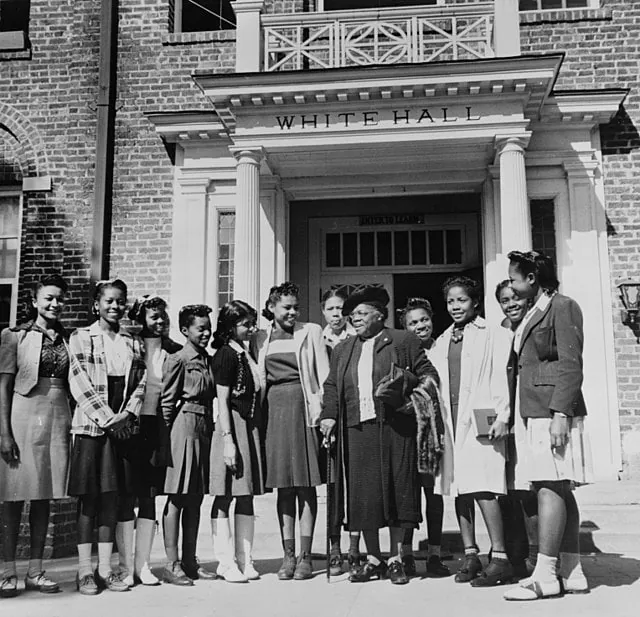Welcome to our exploration of the female leaders of the American civil rights movement, whose strength, intelligence, and tenacity helped shape the course of American history. This guide delves deep into the lives and legacies of these remarkable women, revealing how their contributions to one of the most crucial human rights movements continue to influence us today.
Whether you’re a history buff, a student, or someone keen on understanding the roots of modern civil rights and gender equality struggles, this guide offers valuable insights. We celebrate their well-known public achievements and the personal journeys and challenges they overcame, which fueled their activism and leadership.
So, if you aspire to make an impact or simply wish to learn from the best, read on. Discover how these powerful women used their voices, intellect, and indomitable spirit to fight for justice—and how you can do the same in today’s world.
Celebrating Female Leaders of the Civil Rights Movement
The civil rights movement is renowned for its vast impact on social change, largely driven by influential female leaders. These dynamic women-led pivotal events shaped the movement’s direction through unwavering courage and sharp intellect. Here, we pay homage to a few remarkable female leaders whose contributions were indispensable.
Unsung Heroes and Prominent Figures
While names like Rosa Parks and Coretta Scott King are widely recognized, many other women played crucial roles behind the scenes. They organized, strategized, and spoke bravely, often amid great personal risk. Each leader’s story reminds us of the collective effort required to confront entrenched prejudices and incite legislative changes.
- Rosa Parks: Arrested for refusing to give up her bus seat, sparking the Montgomery Bus Boycott. Her act of defiance became a symbol of the struggle against racial segregation.
- Ella Baker: A brilliant organizer whose work with the NAACP, SCLC, and SNCC helped shape the movement’s strategic direction. Baker believed in democratic activism, encouraging grassroots involvement over hierarchical leadership.
- Fannie Lou Hamer: Emerged from brutal poverty and oppression in Mississippi to become a powerful voice for voting rights and racial equality. Her famous phrase, “I am sick and tired of being sick and tired,” encapsulated the frustrations of countless African Americans in the South.
Moving Beyond the Margins
These female leaders contributed significantly within their communities and altered the broader narrative around civil rights. They advanced the concept of intersectionality, connecting gender, race, and class in a cohesive push for universal human rights.
Their legacies are not just historical footnotes but active inspirations for current civil rights challenges. For those looking to delve deeper into the intricate details of these leaders, informative resources are necessary. Libraries and educational websites offer a treasure trove of information, such as the National Archives Civil Rights and National Women’s History Museum, where you can explore extensive material on these formidable women.
As we continue to advocate for equality and justice today, remembering and studying these female civil rights movement leaders offers not only education but also motivation. Their profound impact echoes in every step we take towards a fairer society.
Core Influences: Before the Spotlight
Long before they were leaders, the women of the civil rights movement were shaped by personal experiences and societal observations that forged their resolve to fight for equality. Understanding their backgrounds offers valuable insights into their motivations and strategies.
Roots of Resilience
Many female leaders in the civil rights movement came from humble beginnings, facing racial and gender discrimination from a young age. These early experiences highlighted the stark inequalities within society and ignited a strong desire to forge a better path.
- Septima Clark: Known as the “Mother of the Movement,” her experiences with deeply ingrained racism in the education system led her to develop citizenship schools that were crucial for increasing Black voter registration.
- Daisy Bates: Orphaned and raised by family friends, Bates would later channel her personal anguish into her activism, playing a critical role in integrating schools in Arkansas.
Influential Encounters
Adversity alone did not shape these women’s journey. Influential encounters with peers, mentors, and pivotal historical moments guided their transformation from citizens to activist leaders. Workshops, church meetings, and university groups provided platforms for early activism and networking.
Through such encounters, they gained inspiration and practical skills in organizing, public speaking, and non-violent protest. This preparation phase was critical, arming them with the tools to define their leadership during the most tumultuous times of the civil rights movement.
Key Profiles: Women Who Changed History
Many stalwart female leaders propelled the civil rights movement forward. Each brought distinct perspectives and strategies to the fight for equality.
Organizers and Orators
Effective organization and powerful oration were hallmarks of these leaders’ contributions to the movement.
- Dorothy Height Often stood at the crossroads of women’s rights and civil rights, advocating strongly for both, which broadened the scope of the movement.
- Jo Ann Robinson: Catalyzed the Montgomery Bus Boycott, illustrating how well-coordinated community efforts could effect significant change.
Innovators of Nonviolent Protest
Nonviolent strategies were crucial. The women of the civil rights movement not only participated in but often led these peaceful protests.
- Diane Nash: A key figure in the Freedom Rides. Her commitment exemplifies how strategic peaceful protests led to vital civil rights advances.
- Ruby Bridges: As a child, her brave integration into a New Orleans school symbolized hope and the power of peaceful progress.
In addition, the arts also served as a powerful form of protest and expression among these women, creating impactful moments that highlighted the realities of segregation and discrimination.
This resource enriches our understanding and appreciation of the varied roles that female civil rights leaders played in reshaping American society.
Strategic Contributions: Tactics and Impacts
The tactical acumen of female civil rights leaders was pivotal in many campaigns. Their strategies reshaped public attitudes and led to significant legislative changes.
Grassroots Mobilization
Their ability to mobilize communities at the grassroots level was critical. These leaders understood the power of involving everyday people in the movement.
- Vivian Malone Jones: Pushed for integration at the University of Alabama, symbolizing the fight against educational segregation.
- Constance Baker Motley: A key legal strategist whose work helped dismantle Jim Crow laws, demonstrating the importance of the judicial front in civil rights.
Impactful Demonstrations
Significant demonstrations orchestrated or led by these women often drew national and international attention, bringing the realities of segregation to a broader audience.
- The March on Washington: Although men primarily delivered speeches, women organized and directed much of the logistics and groundwork, proving essential to the event’s success.
- The Selma to Montgomery marches Highlighted the critical role of women in sustaining these prolonged efforts, which were vital in passing the Voting Rights Act of 1965.
To explore more about the legislative impacts of the civil rights movement, resources like the Library of Congress Civil Rights History Project provide detailed information and firsthand accounts that illustrate these monumental efforts.
Legal and Legislative Triumphs
Female civil rights leaders were instrumental in securing legal and legislative victories that reshaped American law and society.
Landmark Legal Cases
Key legal battles won through the courts helped dismantle systemic barriers to equality.
- Shirley Chisholm: The first black woman elected to the U.S. Congress. She advocated for women, pushing significant legal reforms.
- Charlayne Hunter-Gault: Fought for and won the right to attend the University of Georgia, setting a precedent for educational integration.
Legislative Achievements
These women challenged unjust laws and helped create new ones that fostered equality and justice.
- The Civil Rights Act of 1964: Women played key roles in lobbying for and drafting this crucial legislation.
- The Voting Rights Act of 1965: Their persistent efforts ensured the passage of laws that guaranteed voting rights for all Americans, regardless of race.
The work of these leaders extended beyond protests, shaping policies that continue to influence the U.S. today. For those interested in the detailed legal aspects of the movement, visiting the U.S. Courts educational resources can provide deeper insight into the cases that changed history.
Cultural Impact and Lasting Legacy
The female leaders of the civil rights movement left an indelible mark on American culture, and their legacy continues to inspire new generations.
Shaping Modern Media and Literature
Their stories and speeches have influenced various media, including literature, films, and music, spreading their message of equality and justice.
- Maya Angelou: Her literary works, such as “I Know Why the Caged Bird Sings,” offer profound insights into the black experience and the fight for civil rights.
- Angela Davis: Her books and speeches have continued to inspire discussions about race, class, and gender in America.
Inspirational Figures in Contemporary Movements
The techniques and strategies developed by these women are still used in modern civil rights advocacy, proving their timelessness and relevance.
- Black Lives Matter: This movement has roots in the strategies and moral force of the civil rights era, emphasizing nonviolent protest and community organizing.
- Women’s March: Echoes the inclusive and intersectional approach first championed by female civil rights leaders.
These leaders changed laws and transformed societal norms and perceptions about race and gender. Their lives inspire books, movies, and courses that can be explored to better understand their contributions. For further exploration, educational resources like Smithsonian’s profiles of civil rights heroes provide comprehensive insights into their lives and legacy.
Connecting Current Challenges to Past Struggles
The strategies and ideals championed by female civil rights leaders still resonate deeply in today’s social justice campaigns.
Continued Influence in Modern Advocacy
The tactics and perspectives developed by these leaders continue to provide a blueprint for addressing contemporary issues.
- Advancing Racial Equality: Movements today draw on the organizing strategies and public messaging techniques pioneered by these women.
- Gender Equality: Their intersectional approach strongly informs current debates and actions to secure equal rights and opportunities for all genders.
Educational Impact and New Generations
Organizations like the NAACP still fight for civil rights, drawing on the legal and organizational foundations laid by these impactful women. For a direct link to historical archives and present-day resources, the Crusade for Justice provides a rich database of civil rights literature and materials that are crucial for education and advocacy efforts today.
FAQs
Here are some frequently asked questions about the female leaders of the civil rights movement to enhance your understanding and appreciation of their contributions.
Who were some notable female leaders of the civil rights movement?
Rosa Parks, Ella Baker, Fannie Lou Hamer, and Dorothy Height are just a few. Each played a crucial role in shaping the movement.
What were the major contributions of these leaders?
They led protests, organized communities, influenced legislation, and much more. Their work significantly advanced civil rights in America.
How did these women impact today’s social justice movements?
Their strategies and ideals continue to influence modern advocacy, emphasizing non-violence, grassroots organizing, and inclusive dialogue.
Where can I learn more about these inspirational figures?
Visiting National Park Service pages on female civil rights leaders or checking resources at your local library would be excellent starts.
Why is it important to study these leaders in the context of today’s challenges?
Understanding their methods and challenges enriches our approach to contemporary social issues, offering proven strategies and motivational examples.
Conclusion
The female leaders of the American civil rights movement have left us an extraordinary legacy of courage, resilience, and tactical brilliance. Their impact stretches far beyond the historical moments of the 1950s and 60s, reaching into the very fabric of current civil rights and gender equality movements.
As we continue to face civil rights challenges today, it’s crucial we remember the strategies and hearts these women brought to their cause. Understanding and applying their lessons can inspire and guide us in pushing for necessary changes in society today. Let their lives and sacrifices motivate us to strive for a more inclusive and just society.
If these stories inspire you and you want to impact your community, consider joining Diversity Employment. Here, you can connect with others who are equally passionate about promoting diversity and inclusion positions in every sphere. Together, we can continue the work that these remarkable women started.




